Monitoring Effectiveness of Road Stormproofing BMPs
In 2017, the San Francisco Bay Regional Water Quality Control Board adopted the Vineyard General Permit to increase water quality in local watersheds. The General Permit regulates pollutant discharges from vineyard properties located in the Napa River and Sonoma Creek watersheds. It requires implementation of best management practices (BMPs) to control sediment discharge and storm runoff increases from farms and unpaved roads, and actions to control discharge of pesticides and nutrients.
The plan approved by the Water Board requires monitoring of vineyard properties to evaluate the effectiveness of these BMPs to reduce sediment discharge within the vineyard footprint and from unpaved roads. The Water Board also requires the monitoring of sediment levels in streambed sections that provide habitat for steelhead and/or salmon.
Staff from Napa County and Sonoma RCDs monitored the four BMPs that were most commonly recommended to help vineyard properties reduce sediment delivery from unpaved roads- critical dips, trash racks, waterbars, and rolling dips.
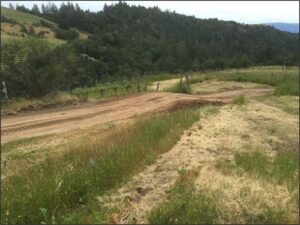
Example of a rolling dip.
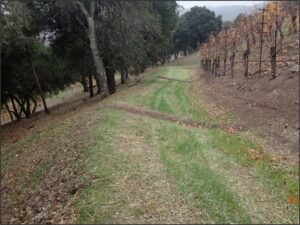
Example of a waterbar.
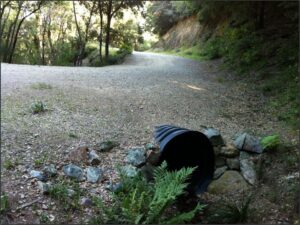
Example of a critical dip to the right of culvert.
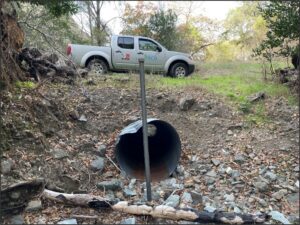
Single post trash rack installed at the culvert inlet.
Rolling dips and waterbars are used to prevent road surfaces from draining into the stream system. Critical dips and trash racks are installed at stream crossings that have culverts, and are designed to reduce the occurrence of plugged culverts and, if a culvert does get plugged, to reduce the chances that water will just run down the middle of the road – which adds to sediment runoff issues.
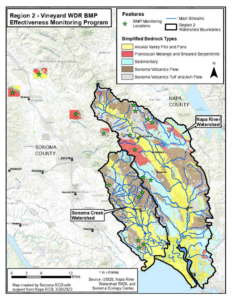
A total of 484 BMP implementation sites were monitored by RCD staff in the four types of underlying bedrock known to exist in the Napa River and Sonoma Creek watersheds.
Overall, RCD staff found that the effectiveness of all four types of BMPs was extremely high; over 90% of the BMPs of each type were effective. The only exception to this were waterbars that were constructed on high use roads. Waterbars are more appropriate for roads that are not driven during winter months or on roads where the Waterbars are repaired/monitored after each passage of a vehicle.
To see examples of the BMPs and read more, head over to our Resources Page! Find Conservation Practices-> Unpaved Roads-> and explore to your heart’s content!
